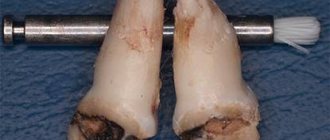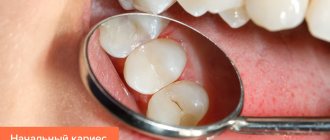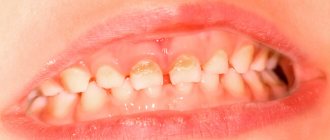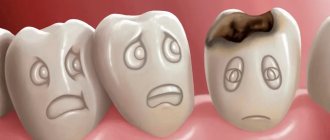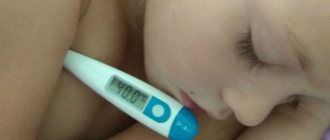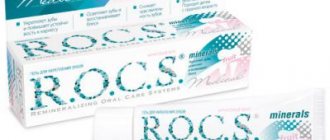Caries of primary and permanent teeth in children is a disease that affects more than 70% of young patients. Therefore, every parent needs to know how to deal with it. You should not neglect the treatment of baby teeth, believing that permanent teeth will grow healthy and strong - this is a very common myth.
Caries in children is an infectious disease, so it affects not only already formed milk teeth, but also the rudiments of permanent teeth.
Another argument of those parents who put off visiting the dentist is their own fears and fear of exposing their baby to stress.
A visit to the modern Novodent dental clinic in Moscow guarantees treatment using modern methods. The baby will not feel pain. If the fear of a small patient is too strong, treatment can be carried out in a dream; the drugs used in this case are absolutely harmless to the body. Also, qualified doctors will tell you what to do to prevent caries in children.
Features of superficial caries
Among the main distinctive features of superficial carious damage to teeth in children in comparison with other forms of pathologies, the following should be noted:
- only the enamel layer is affected by pathogenic formations. The dentin remains intact. With timely treatment, the risks of complications are minimal;
- the occurrence of an acute reaction to external stimuli, for example, sour and sweet foods, low and high temperatures;
- if superficial caries is diagnosed in children, treatment can be carried out without tissue preparation;
- Most often, the superficial form occurs in children aged 3-4 years and in adolescents.
Note! Initial caries and superficial caries are two completely different forms. The first appears as a small spot, the second occurs in the absence of treatment. It can be recognized by the presence of small-sized carious cavities.
What are caries and pulpitis?
Caries is a disease in which the hard tissues of the tooth are destroyed due to the loss of minerals from the tooth enamel.
How and why caries forms, read our article on the treatment of caries. The carious process, progressing, gradually reaches the pulp chamber, in which there is a neurovascular bundle of fibers that nourishes the tooth - the pulp, and destroys it. Bacteria from the carious cavity penetrate inside, infect the pulp, it becomes inflamed and pulpitis begins.
Both adults and children suffer from caries and pulpitis, but the course of the disease at different ages and its treatment differ.
Read about the treatment of caries and pulpitis in adults and pulpitis in baby teeth in the sections dedicated to these topics. In this article we will tell you about the treatment of caries and, especially, pulpitis of permanent teeth in adolescents, as well as about its features.
Symptoms of the disease
Symptoms of superficial foci of caries are manifested by the following signs:
- visible defect. On the surface of the tooth there is a small cavity with uneven edges. The color of the formation is dark, the bottom is slightly rough;
- pain syndrome. When exposed to cold, hot, sweet and sour foods or drinks, sharp short-term pain occurs;
- hyperesthesia. When inhaling cold air, while brushing your teeth, increased sensitivity occurs.
These are the main symptoms and in each individual case they can manifest themselves differently.
Prevention of caries. Expert advice.
From the above, it is clear that sweets are not as bad as poor personal hygiene. The best prevention of caries is timely removal of plaque.
. There is no need to constantly visit a doctor for this. High-quality personal hygiene is available to us on our own. It is enough to follow a number of simple but very practical rules:
- Brush your teeth after every meal. Of course, this is not always possible in real life. If it is not possible to brush your teeth during the day after a “snack”, rinse them with water;
- Brushing your teeth at least 2 times a day (morning and evening) is MANDATORY. It is especially important to brush your teeth before going to bed, as little saliva is produced at night and practically nothing prevents the growth of bacteria. There is a sharp increase in the amount of acid released that affects the teeth, increasing the risk of developing caries;
- DO NOT EAT sandwiches. This is harmful not only for teeth, but also for the entire gastrointestinal tract, since proper wetting of food does not occur;
- Carbonated sweet water is very harmful not only to your teeth. Soda contains phosphorus or carbon dioxide in low concentrations, which provokes the leaching of calcium salts from the teeth. Due to this, the surface of the teeth becomes more susceptible to the action of bacterial acids, and plaque adheres to it better. If you cannot refuse your child soda, then at least let him drink regular still water after soda;
- Taffy, toffee, lollipops and lollipops should be excluded from the diet. They easily stick to teeth and take a very long time to dissolve, bringing a lot of joy to carious bacteria. THE LONGER SWEETS ARE IN THE ORAL CAVITY, THE HIGHER THE RISK OF DEVELOPING DENTAL CARIES;
The best prevention of dental caries is personal hygiene. By teaching your child to brush their teeth, you will protect them from decay.
Factors influencing the development of superficial caries in children
The fundamental factors that result in superficial caries in children are:
- eating foods that contain large amounts of carbohydrates;
- non-compliance with hygiene rules: insufficient brushing of teeth, ignoring periodic rinsing with special means, etc.;
- drinking water with a deficiency of fluoride in its composition;
- deficiency of vitamins and mineral elements;
- severe systemic diseases;
- hormonal imbalance;
- ignoring professional hygiene, the need for which arises every 5-6 months.
Any of these factors or several at once are the primary causes of tooth enamel destruction.
Diagnosis of multiple caries
If the above-described symptoms appear in a child’s oral cavity, parents should definitely visit a doctor with him. Even if the dark spot is small in appearance, there may be a large carious cavity underneath it.
The specialist will examine the dentition and take measures to confirm or deny the diagnosis. For this, a dental mirror and probe are sufficient.
If necessary, the doctor will order an x-ray or use the transillumination method: using bright light to highlight dark carious cavities inside the teeth. If multiple caries is confirmed in a child, a number of therapeutic measures are prescribed.
Principles of treatment of superficial caries
When superficial caries is detected in children, treatment should be aimed not only at eliminating formations on the tooth enamel, but also at preventing the re-development of the pathology. To prevent complications, comprehensive and immediate therapy is necessary.
When talking about treatment, it should be understood that it is just beginning in the dentist’s office, and it will also need to be continued at home using special means and traditional medicine recipes.
Features of treatment in the pediatric dentist's office
If baby teeth are damaged by caries, then it is quite possible to treat them conservatively without the use of drills, which almost every child is afraid of. Modern dentistry offers more gentle and comfortable methods:
- Children under 3 years of age undergo silvering or deep fluoridation of their teeth. If the enamel has already been damaged by caries, it is cleaned of plaque and treated with a laser. If necessary, cracks in the chewing and frontal teeth are sealed;
- at the age of 3 to 5 years, ozone therapy can be performed to eliminate the first stage of superficial caries, and in case of major complications, treatment is carried out using the method of depophoresis. Its essence lies in the introduction directly into the root canals of a special composition with calcium and copper;
- Children from 5 to 9 years old undergo filling. Glass ionopolymers or colored compomers are used for fillings;
- Children aged 9 to 12 years already have molars and adult technologies can be used to treat them with minimal trauma. But in most cases, therapy of chewing teeth is carried out by sealing fissures.
When superficial caries in children requires complex dental procedures, local anesthesia is mandatory before such procedures are performed. If removal is necessary, such an intervention can be performed under intravenous anesthesia.
Treatment at home
Along with professional treatment of caries by a pediatric dentist, proper oral care at home will also be required to obtain an effective result. For this purpose, special rinsing compositions and toothpastes with anti-caries effects are used.
For children under 4 years of age, dental and oral care products should not contain fluoride. The therapeutic effect is provided by antibacterial active components and calcium ions.
Children over 4 years old are allowed hygiene products containing fluoride, only the concentration of the element must be minimal.
LACALUT kids, PresiDENT Baby, SILPA Putzi, Splat junior are considered good toothpastes for children. You need to brush your teeth with them twice every day. Among the rinses, Drakosha for children, Active Kids, and LACALUT Teens have proven themselves well. When treating caries with such solutions, it is necessary to rinse your mouth after every meal and always before going to bed.
In addition to professional medications, you can also use remedies prepared according to alternative medicine recipes:
- An infusion of chamomile is perfect as a rinse. To do this, pour a glass of boiling water into 1 tbsp. l. dried flowers, leave and cool to room temperature;
- a weakly concentrated solution of sea salt has a positive effect on the condition of teeth. Dissolve 0.5 teaspoons of salt in a glass of water and use for rinsing.
Important! Rinse aids can only be used after the child reaches 1.5-2 years of age, when he can already rinse and spit out liquid on his own, rather than swallow it.
What will happen if left untreated?
Caries of primary teeth is characterized by rapid development and rapid transition to a complicated stage. Without adequate treatment, this leads to the destruction of a temporary tooth. Therefore, it is very important to pay attention to the condition of the child’s oral cavity.
It is worth noting that very rarely in children only one tooth is affected by caries. Most often, this process extends to several baby teeth. After suffering “childhood” acute infectious diseases (measles, scarlet fever, tonsillitis), the enamel may become thinner and a carious process may also develop. Children with chronic diseases of the respiratory system: asthma, tonsillitis, enlarged adenoids are also at risk.
If you do not undergo regular oral hygiene and do not pay attention to the condition of baby teeth, then dark spots and dots appear on the chewing surface, the surface of the tooth ceases to be smooth, and sensitivity appears when eating and drinking. the child may behave restlessly and refuse to eat. Bad breath may appear; with moderate or deep damage, a “hole” in the tooth may be observed. If you do not consult a doctor at this stage, caries will develop into pulpitis, which will be accompanied by acute pain that cannot be ignored. This will be very stressful for the child, so it is recommended to visit the dentist regularly.
Possible complications
Some parents are in no hurry to visit a pediatric dentist because they consider it useless to treat baby teeth. This approach is explained by the fact that permanent ones will grow instead of them anyway.
Although the carious process itself does not transfer from baby teeth to permanent ones, untreated caries lesions have a detrimental effect on the condition of the latter. If you ignore superficial caries in children , complications may very soon manifest themselves:
- caries progresses rapidly in the absence of adequate therapy. This leads to the development of periodontitis and damage to the molar tooth germ. The inflammatory process significantly slows down the eruption of permanent teeth and complicates their growth;
- premature loss of baby teeth leads to the formation of malocclusion and disrupts the structure of the maxillofacial system;
- If at least one tooth is missing in the dentition, this complicates the process of chewing food. As a result, problems arise with the functioning of the digestive system.
Remember! Even the smallest stain can lead to complete tooth decay. There is no need to risk your child's health. It is much easier to visit the dentist and, if necessary, treat caries.
Caries of baby teeth
Often, parents do not understand the importance of treating baby teeth. However, it is important to understand that caries does not happen to children. This is an infection that affects the body as a whole and can spread to the permanent teeth that then appear. Sick children's teeth hurt just like adults. Children pay great attention to appearance and evaluate each other. Often a child with bad teeth is subjected to pressure from others and becomes a victim of ridicule. This causes additional psychological discomfort, along with toothache. In case of partial absence of teeth or present discomfort, the child’s speech may be impaired, which leads to speech therapy defects.





